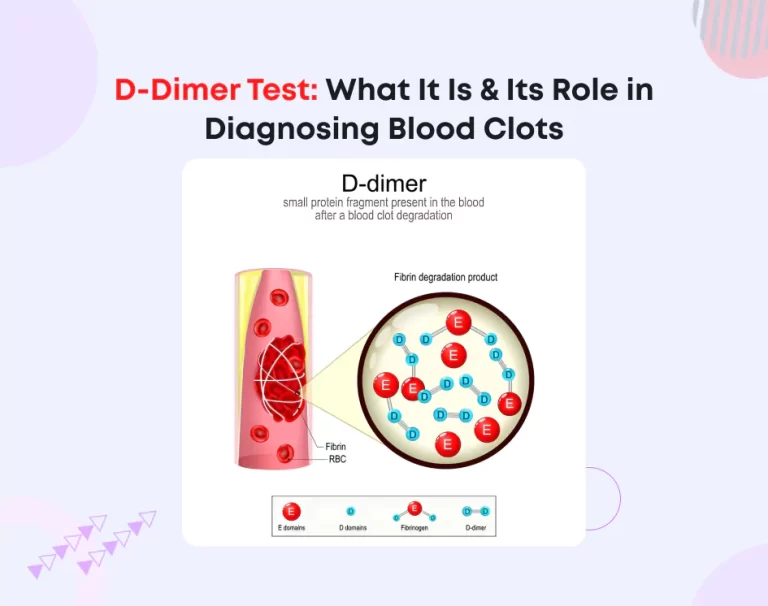
D-Dimer Test: What It Is & Its Role in Diagnosing Blood Clots
The D-dimer test is a widely used blood test that helps doctors assess whether there are abnormal levels of clotting activity in the body. It is commonly used in the diagnosis of blood clotting disorders, especially when conditions like deep vein thrombosis (DVT), pulmonary embolism (PE), and disseminated intravascular coagulation (DIC) are suspected. If you’ve ever had a D-dimer test or are preparing for one, you might be wondering exactly what it is, how it works, and what the results mean.
What is the D-Dimer Test?
The D-dimer test measures the presence of a protein fragment that is produced when a blood clot breaks down in the body. When blood clots form, they go through a natural process of breaking down over time. This breakdown process releases small protein pieces into our bloodstream. The D-dimer is one of those protein fragments, and it serves as an indicator that clotting is occurring.
Why is it Important?
The D-dimer test is crucial for detecting excessive clot formation and breakdown in the body. If a person has symptoms suggesting a blood clot such as swelling, pain in the legs, or shortness of breath, the test can help doctors determine whether a clot is present or not. However, it’s important to note that a high D-dimer level alone is not enough to confirm a diagnosis. It usually requires additional tests and imaging to fully evaluate the situation.
What Does the D-Dimer Test Measure?
When you undergo a D-dimer test, your doctor is primarily looking for clot breakdown products in your blood. Here’s how it works:
Blood Clot Formation: If a clot forms in the body, a substance called fibrin is involved in the clotting process.
Clot Breakdown: Over time, the clot naturally dissolves, and as it does, small pieces of fibrin (called D-dimers) are released into the bloodstream.
D-dimer Levels: Higher than normal D-dimer levels indicate that abnormal clotting is taking place, either from a recent clot formation or ongoing clot breakdown.
Common Uses of the D-Dimer Test
Pulmonary Embolism (PE): PE occurs when a blood clot breaks loose and travels to the lungs, causing symptoms like sudden shortness of breath and chest pain.
Deep Vein Thrombosis (DVT): DVT is a clot that forms in the deep veins of the legs, leading to swelling, pain, and redness.
Disseminated Intravascular Coagulation (DIC): This is a serious condition where abnormal clotting occurs throughout the body, often due to infections, trauma, or other underlying diseases.
Clotting Disorders: People with known clotting disorders, such as antiphospholipid syndrome or factor V Leiden, may have their D-dimer levels checked regularly.
Normal Range of D-Dimer Levels
Generally, the normal range for D-dimer levels is less than 500 ng/mL (nanograms per milliliter). However, the reference range may vary slightly depending on the laboratory conducting the test and the type of testing method used. Some labs may provide different cutoffs or report D-dimer in different units, so it’s important to always discuss your results with your healthcare provider.
What Does a High D-Dimer Mean?
A high D-dimer result doesn’t really mean you have a blood clot. In fact, elevated D-dimer levels can be caused by a variety of factors, including:
- Acute or chronic inflammatory conditions (like infections or autoimmune diseases)
- Trauma or injury (especially to large blood vessels)
- Surgical procedures
- Pregnancy (D-dimer levels tend to rise in pregnancy, particularly in the later stages)
- Liver disease or kidney disease
- Cancer (certain types of cancer can elevate D-dimer levels)
- Recent surgery or physical injury
In these cases, the elevated D-dimer is more likely a sign of an inflammatory process or injury rather than an actual blood clot. Therefore, a high D-dimer level requires further investigation to determine the cause.
What Does a Low D-Dimer Mean?
A low D-dimer level is generally considered a good sign. It usually suggests that there is no ongoing clotting activity in the body.
A normal or low D-dimer result can help doctors rule out blood clotting disorders in many cases. For instance, if you’re experiencing mild or non-specific symptoms, such as leg swelling or chest pain, a low D-dimer level may indicate that a blood clot is not the cause.
And if you’re on blood thinners, your D-dimer levels may appear normal or low, even if you have a clot. This could lead to a false-negative result, so your doctor may need additional tests, like an ultrasound or CT scan, to confirm the presence of a clot.
Limitations of the D-Dimer Test
While the D-dimer test is very useful, it is not without its limitations. A high D-dimer might suggest the presence of a clot, it doesn’t pinpoint where the clot is located or confirm that a clot is the cause of symptoms.
When Should You Get a D-Dimer Test?
If you experience any of the following symptoms, you might be referred for a D-dimer test:
- Sudden shortness of breath, especially if it’s unexplained
- Swelling or pain in one leg (often associated with redness or warmth)
- Chest pain, particularly with difficulty breathing
- Coughing up blood
However, it’s important to remember that D-dimer testing is often used in combination with other diagnostic tools and a clinical evaluation to arrive at a final diagnosis.
Conclusion
The D-dimer test is a helpful tool for detecting abnormal blood clotting in the body. While it can’t definitively diagnose a blood clot on its own, it provides valuable information that can guide further testing and treatment. A normal D-dimer level typically indicates that there is no significant clotting activity, while a high D-dimer level could suggest a clotting disorder or other serious health condition that needs further investigation. Always consult with your healthcare provider to understand your D-dimer test results and their implications for your health.








